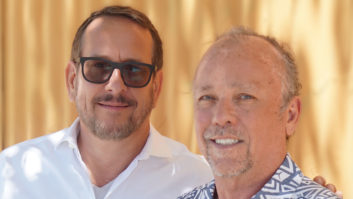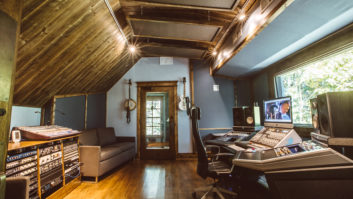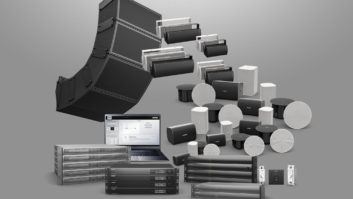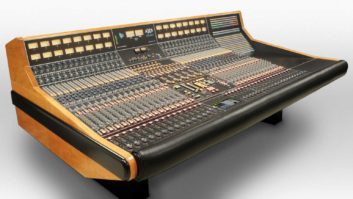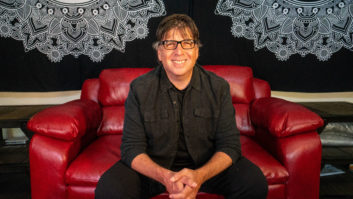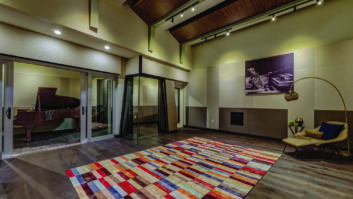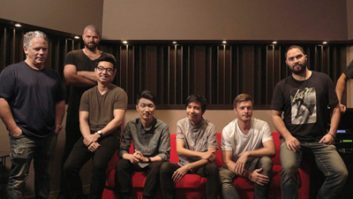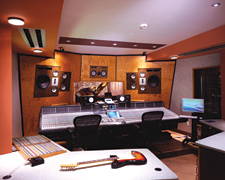
THE BARBERSHOP
Designed by Fran Manzella of Francis Manzella Design Ltd. and housed in a 100-year-old stone church on New Jersey’s Lake Hopatcong, The Barbershop is the Tri-State area’s newest 5.1 and 7.1 recording, editing, mixing and mastering facility. Cathedral ceilings, stained-glass windows, old-style herringbone wood panels, revealed veneer curly maple panels and hints of the building’s original stone characterize the spacious live room, which is built, like the two control rooms, on a floating floor. “Being able to integrate elements of the church throughout its various incarnations into a ‘new’ design that juxtaposed much of the old with newer architectural and acoustic elements turned out to be very interesting and rewarding,” says Manzella. “All in all, I’d have to say this is one of our most successful design projects to date.”
Studio A offers a 72-channel SSL XL9072 K Series desk, custom Griffin studio monitors and Griffin G2A 5.1 surrounds, a Pro Tools|HD Mix system and ample new and vintage mics and outboard gear. The smaller Studio B features an additional HD rig, a Genelec 8050A surround system and an iso booth. Amenities include an on-site Italian restaurant, full-service marina and in-house production services courtesy of its owners, Mark Salamone and Scott Barber. “We wanted to create a world-class recording studio where artists can relax and enjoy the lake and the good vibe of the church,” says Salamone. “We went to great lengths to create a beautiful environment for people to work and an even more beautiful-sounding room.”

photo: Ed Freeman
BOMB SHELTER STUDIOS
Launched in January 2005 by producer/former Stone Temple Pilots drummer Eric Kretz, who partnered with Professional Audio Design’s Dave Malekpour on design, the L.A.-based Bomb Shelter’s worldly feel comes from abundant ethnic fabrics and soft lighting in the spacious control room, as well as the 100-year-old tri-color brick walls, custom acoustical treatments incorporating African poplar, exposed wood beam ceilings, and perforated steel and insulated diffusors that adorn the 2,500-square-foot tracking room. Equipment includes an SSL 4048 G+ with Neve sidecar, Pro Tools|HD3, outboard gear from TC Electronic, Lexicon, Tube-Tech, dbx, Alan Smart, Empirical Labs and Drawmer, and a closet of Neumann, Royer, AKG, Shure, Sennheiser, Crown and Lawson mics. Monitoring is via KRK, Tannoy and Yamaha models. Thanks to a recent partnership with RETRO ROOM, the studio now incorporates a 10-channel Helios, Fairchild 670 and Studer Mark III with JRF 2-inch 8-track headstack. Bonus: A 2,000-square-foot lounge and half-court basketball provide ample space for stress-relieving activities.

photo: Martin Pilchner
CHERRY BEACH SOUND
Cherry Beach Sound opened in January 2005 in the heart of Toronto’s port area. The full-service music, audio post, commercial production, CD mastering and audio enhancement facility’s newly designed (by Martin Pilchner of Pilchner Schoustal) Control Room A features an SSL 6056 E/G+, Genelec 1034B surround mains with 7073A subwoofers and Bryston 4Bs for the Yamaha NS-10M studio monitors. Recording/mixing options include Pro Tools|HD (with ProControl Edit Pack) and Studer A827 2-inch 24-track and A810 ¼-inch 2-track. Outboard gear includes pre’s and EQs from Neve, Manley and API; Focusrite ISA 110 modules; processing from UREI, Neve and SSL; and the prized EMT 140 stereo plate reverb. A glass-walled corridor between the control room and studio optimizes lines of sight.

photo: Jared Milgrim
CIDER MOUNTAIN RECORDERS
Cider Mountain offers seven flexible recording spaces, including a 1,600-square-foot tracking room with 20-foot-high ceilings, two control rooms, an editing suite and guest accommodations, all situated on 240 acres just north of Coeur d’Alene, Idaho. The spacious live room offered designer Chris Pelonis “the palette required to create an extremelyinvolved trapping and diffusion system rarely experienced,” he says. Studio A features a 64-channel API Legacy Plus, along with a Pelonis Signature Series PSS215AW main monitor system and ADAM S3As near-fields. Clients can record to Studer A827 Gold Edition 24-track analog or Pro Tools|HD using the studio’s 22 API 512s; Neve 1057 and 1073s; Manley, Millennia and Ampex tube pre’s; and more. Studio B features a Trident TSM console with Pelonis Signature Series PSS115AW monitor system, a Studer 880 and aPro Tools|HD3 rig.

photo: Justin Maconochie
EFFIGY STUDIOS
Engineer Thomas Johnson returned to his native Detroit to open Effigy Studios, a 7,862-square-foot space designed by Vantine/Guthrie Studio of Architecture in Northville, Mich. Four years in the making, Effigy opened in November 2004. The birchwood-dominated space features a main room with 17-foot ceilings, no parallel walls, multipurpose iso booth and adjoining vocal booth. The large control room, directly visible from all three rooms, contains a 48-input API Legacy Plus, Pro Tools|HD3 and a custom TAD monitoring system with ADAM SA3 near-fields. Outboard gear includes units from ADL, Drawmer, Daking, dbx, Empirical Labs and Manley, while the mic list offers AKG, Beyer, Earthworks, Electro-Voice, Neumann, RØDE, Royer, Sennheiser and Shure models. Classic gear is provided by local reseller Vintage King.

photo: Dick Raspscrot
FUTURE POST
Opened in February 2005, Future Post in Los Angeles handles sound design and mixing for TV and radio trailers, promos and long-form shows in stereo and 5.1, game sound, DVD remastering and more. The studio’s shell was originally built in 1990, but everything else — from floors to fabric walls — was designed by owner Paul Robie and design/integration consultant Chip Mullaney, with construction and wiring assistance from Alexander Lvov and WIRE. A Yamaha DM2000 with Argosy enclosure serves as “master control,” powered by Pro Tools|HD3 and Logic workstations running on Apple G5s. Other equipment includes CEDAR DNS2000, Dolby 563/564 surround encoder/decoder, Sony A-500 Digital Betacam, Tascam DA-98s and Mackie Universal Control.

photo: George Roos
HEADROOM DIGITAL AUDIO
Headroom’s (New York City) three studios each have their own iso booths and the equipment to handle voice-overs, music recording/mixing and post services. Control rooms A and B both offer Yamaha DM2000 consoles, Genelec 8040 5.1 monitoring systems and a Furman multichannel personal monitoring system. Their Pro Tools|HD3 rigs and video playback systems (Virtual VTR) all run on dedicated G5s. Designer Fran Manzella combined “modern and Tuscan palazzo styles, including an etched concrete floor and Venetian plaster walls to create a distinctive, relaxed and uniquely client-friendly atmosphere.”

photo: Roscoe Weber
ST. CLAIRE RECORDING
Owner John Parks created his dream studio when he launched St. Claire Recording, a one-room facility in Lexington, Ky., this month. Two years in the making, the 7,800-square-foot “retreat facility,” designed by Pilchner Schoustal, boasts an ultra-spacious control room with an 80-input SSL 9000J console and Pro Tools|HD3 Accel, along with a RADAR system with Nyquist AD/DA, Princeton Digital Reverb 2016, Korg Tape Echo, Lexicon 960LS, Manley Massive Passive and more. The surround setup includes a Pilchner Schoustal-designed Max Monitor System and pairs of ADAM S3As and Auratones. The live room contains four iso booths and, like the control room, ample natural light and a view of the Kentucky countryside. Guest accommodations are also on-site.

photo: Lou Johnson
HIGH POINT MANOR
Designed by Carl Tatz of Carl Tatz Design, one-year-old High Point Manor in Brentwood, Tenn., features a dual CTD PhantomFocus monitor system, with Dynaudio M3 and BM6A monitors, 12S subwoofers and Bryston 7B SSTs; mains and near-fields share the same subwoofer system, which is achieved through a custom Event Horizon switcher, allowing the use of NHT X2 crossovers and Meyer CP10S EQs for each 20 to 20k Hz system. First reflections are attenuated with ASC half-rounds and Perue Acoustics wedge diffusers installed behind acoustically transparent fabric in the rear sidewalls. Pro Tools|HD3 with Argosy console, Tube-Tech compressors, Groove Tubes Vipre and Great River preamps, Alesis Masterlink and Aviom cue system round out the facility.

photo: Karian Studios
KARIAN STUDIOS
Owned by music industry players Ian and Karen D’Sousa and designed by Nashville-based Christopher Huston, Karian Studios occupies part of a 10,000-square-foot Mediterranean estate in Gallatin, Tenn. The control room features a custom SSL 4072 E/G+ with Total Recall, Pro Tools|HD3 Accel and Otari RADAR II, as well as outboard gear from Universal Audio, Neve, API and Focusrite. Genelec 1036s and Dynaudio M2s hold monitoring duties. The 1,000-square-foot live room features 20-foot ceilings, Brazilian walnut floors and four iso booths. Karian also offers a writing room for composers and arrangers and a mastering suite with Sonic Studio HD. Amenities include overnight accommodations, access to a courtyard with bistro area, tea with white linen and a guard dog.

photo: Stephen Briggs
SILVERTONE RECORDING STUDIO
Silvertone, which opened in Groton, Mass., last September, is based around the 40-channel Sphere Eclipse C discrete console formerly used in producer Brian Ahern’s famed Enactron Truck. Built by owner Neal Ward and designed by Michael Blackmer, the vibe-y facility uses rough-cut wood in both the tracking and control rooms, while the live room contains variable acoustic treatments through the use of five large rolling bookshelves that can be used to create isolated areas anywhere in the room. In addition to the Sphere, the control room contains outboard gear from Neve, Helios, Universal Audio, dbx, Avalon and John Hardy, Melcor modules, Sony DRE-777 and Lexicon 480 reverbs, Pro Tools|HD and iZ RADAR recording options, and a collection of both “standard and unusual” studio mics.

photo: Mike Perla
STUDIO:METRONOME
Built on a 100-acre hilltop in southern New Hampshire just over a year ago and designed by John Storyk of Walters-Storyk Design Group, this tracking/mixing room has attracted such clients as The Hives, Phil Vassar, Interpol, Tesla and The Pixies, among others. The control room features an SSL 4048 G+ with TR/Ultimation, Pro Tools|HD with 48 analog I/O and such outboard gear as Neve 1073/1066s, Pultec EQs, Universal Audio and Teletronix compressors, a full API rack, an Echoplate II and a large vintage mic collection. Monitoring includes Boxer T5 mains, Blue Sky surrounds, Genelec 1032s and KRK 8Ts. The live room contains a Yamaha C7 grand piano; location and broadcast recording are provided by MetroRemote, the studio’s 64-input Amek-equipped mobile recording and broadcast truck.

photo: Edward Colver
UNIT EYE
The new studio home of producer Bruce Botnick, Unit Eye (Ojai, Calif.) features a Digidesign ICON, a surround sound system with five freestanding Nautilus speakers and subwoofer, along with cotton acoustical pads and porous polypropylene panels. According to studio bau:ton architect Peter Grueneisen, ideal room proportions, bass traps and curtains control the sound, while indirect and recessed lighting and a flush-mounted flat-panel monitor tie together the visual aspects.
STUDIO RECORDS
This private facility designed by Russ Berger of Russ Berger Design Group was incorporated into the construction of owner John Evans’ new residence in Fort Worth, Texas. The 1,700-square-foot suite includes a control room stocked with a Pro Tools|HD3 Accel workstation, 24-fader ProControl with Edit Pack, and extensive outboard gear from API, Manley, Universal Audio, Avalon, Lexicon, Eventide, dbx, Focusrite and more. The studio area includes a piano booth and an additional iso booth. Notable design features include a custom stretch-fabric wall system for acoustic absorption, cherry wood floors and cabinetry, sound-rated doors and a Lutron GRAFIK Eye control system for lighting and shades. Large sound-rated windows that reach to the floor open up the studio to the control room and piano booth. Double-wall construction isolates the studio from the house and street traffic.

photo: Bill Myerson
BROKEN PONY STUDIOS
Broken Pony is the one-year-old personal project studio belonging to Marietta, Ga.-based composer/author Paul Gilreath. John Storyk of Walters-Storyk Design Group designed the live room to include a series of adjustable treatments that can be opened and closed via hinged doors to change the “liveness” of the room. The control room includes a custom rear panel diffusor system and side-panel absorbtion panels. Equipment includes eight computers running Nuendo, with various soft synths, samplers and “nearly every major piano and symphonic library available,” as well as Apogee Rosetta 800 and Big Ben, NPNG custom Class-A mic preamps, Mackie 1604 VLZ-PRO, Mackie Control Expander, custom Argosy console and racks, and five Mackie 824 monitors.
THE CATHEDRAL
The recording lair of rap artist Snoop Dogg, this Hollywood-based studio features a Mackie Digital X Bus console, Pro Tools|HD, a Mackie Big Knob, two Avalon 737 SP mic pre/compressors and a Mackie Onyx pre. The studio combines traditional near-field monitoring and a “rule-breaking” application of high-powered active P.A. speakers as mid-field monitors, with a setup that includes four George Augspurger 1603Bs with TAD woofers, two Mackie 1801 subwoofers, two Mackie 1530 three-way mid-fields, two Mackie HR824s and two Yamaha NS-10s. The room was originally designed by Carl Yanchar with redesign completed in April 2005 by Snoop and studio manager Nate Oberman.

photo: Robert Wolsch Designs
TRUTONE MASTERING STUDIO B
Ensconced in the original home of the Record Plant, Trutone Mastering Studios in New York City has attracted clients such as Def Jam, Island and Rocafella for its CD and DVD mastering services, as well as its commitment to vinyl. The two-studio complex was redesigned by John Storyk of Walters-Storyk Design Group and re-opened in October 2004. Both rooms feature a Neumann VMS-70 lathe retrofitted with a Zuma disc computer and Technics quartz-controlled turntable motor. The Neumann SP-77 and SP-78 consoles have been extensively modified. Outboard gear includes Weiss BW-102 digital EQ and compressors, Sontec solid-state EQ, Prism and NTP compressors, Pultec vacuum tube equalizers and the highly touted Fairchild 670 compressor. CD masters are created with the Sonic Solutions high-density premastering system. Monitor speakers are KEF Reference 207s; near-fields are Yamaha NS-10s and Tannoy 6.5s, with power supplied by Bryston, McIntosh, Ramsa and Hafler amps.

photo: Edward Colver
AUDIO MECHANICS
Audio Mechanics opened in January 2005 and quickly became one of Southern California’s most in-demand mastering and remastering facilities. Designed for 6.1 from the get-go by Chris Pelonis, the studio’s “Detailing” shop features an ITU placement of five matched dual 15-inch Pelonis Signature Series 215AW mains. Audio Mechanics reportedly boasts “the first ever hybrid acoustical solution to use Pelonis’ patented ‘Edge’ low-frequency technology, combined with RPG’s patented B.A.D.D. diffusion technology.” Sonic HD, Pro Tools|HD, Lexicon 960L, TC M6000 and Genex HD converters fill the control room. A twin mastering room, stereo master/control room, live room with vocal booth for recording and ADR, and a killer jukebox round out the facility.

photo: Rick Schoustal
JOAO CARVALHO MASTERING CORP.
The ultra-roomy Joao Carvalho Mastering in Toronto has the feel of an old English study or library with its warm colors and rich wood. Martin Pilchner of Pilchner Schoustal designed the suite- — which opened on Valentine’s Day 2005 — to be “one of North America’s most acoustically accurate rooms,” with sonic excellence derived from Wilson Maxx Monitors and 2-channel Bryston 14B SST amplifiers, an Airfield Audio mastering console, Pro Tools|HD and peripherals from Weiss, Manley, Waves, Tube-Tech and GML, among others. The comfortable studio borders on decadent, with a fully stocked kitchen and two lounges that seem to ooze world class in both style and sonic quality.

photo: Lou Johnson
YES MASTER
Owned by Nashville mastering engineer Jim Demain, Yes Master’s new suite was designed from the ground up by Carl Tatz of Carl Tatz Design in April 2004. Critical dimension calculations were observed, as well as a proprietary axial mode attenuation protocol. The room features a Carl Tatz Design PhantomFocus Mid-Field System that boasts a 20 to 20k Hz frequency response. Other boxes include Lipinski 707 monitors, Bryston 4B SST amps and M&K 5410 subs. Additional equipment includes Goldpoint SA2X volume control EQ, Millennia Media NSEQ-2 with Telefunken tubes, Weiss EQ1-MK2 and DS-1, Waves Linear Phase EQ and more. Master control includes a Custom PC Wavelab 4 Samplitude 8, BIAS Peak converters, Alesis Masterlink and Ampex ATR-102.

